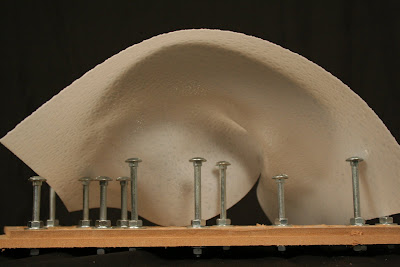
Recap: for the four rows of holes away from center, the clamps are repositioned, and additional height on the jig is added to accomodate the clamps' new position as not to conflict with the formwork.

The added height for the jig only applies for the outer four rows, which means only two holes on the jig, given the formwork's plate can be rotated given the symmetrical nature of the holes about the long axis.

Structural support is then added to the base of the plates to prevent the now perforated surface from breaking under its own weight. Dense wood for molding is used, and the sectional dimension of the supports are determined by the clearance from the washers and nuts (when the bolts are installed).

Six rows of holes per plate. A lot of carriage bolts are yet to be installed. Given the added bracing for the MDF plates, hopefully the dense wood bars will also support the 228 carriage bolts, 456 washers and 456 nuts (calculated at thirty-eight groves and six holes per grove for each plate). Again, washers and nuts are needed to keep the bolts in an orthogonal position, as the holes themselves do not bear enough depth or thread to maintain the bolts' verticality.





























